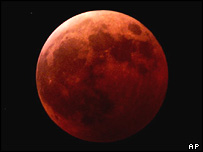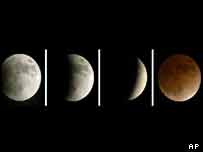|
By Dr David Whitehouse
BBC News Online science editor
|


The colour of the Moon can change
dramatically |
A
total lunar eclipse has been visible this weekend from Europe,
Africa, the Americas, and much of Asia.
The Moon regularly passes into the Earth's shadow and becomes
dimmer. It happens about every six months or so.
A lunar eclipse has no great importance astronomically but can be
enjoyed by many people without special equipment.
The Moon started to enter the outer edges of our planet's shadow
from 2215 GMT on Saturday.
Majestic clockwork
Mid-eclipse took place between 0106 and 0131 GMT on Sunday as the
Moon transited the southern edge of the Earth's shadow.

Skygazers in New York saw the moon gradually
slide into eclipse |
Totality
was quite short this time because the Moon only passed just inside
the full shadow of the Earth, and the Moon's southern edge, in
particular, remained fairly bright.
As the show progressed, the Moon got dimmer and turned reddish
during mid-eclipse, when the only light that could reach the lunar
surface was red light refracted through the Earth's atmosphere.
Astronomers scrutinised the Moon's surface through telescopes to
note how its appearance changed as the Sun was obscured by the
Earth.
The Moon left the last bit of shadow at 0422 GMT.
Skywatchers in North America were able to see the eclipse begin
in twilight as the Moon rose on Saturday evening.
Imperturbable serenity
Although lunar eclipses have no great scientific significance,
they are a spectacle of nature that delights and enthrals.
In the past things were different. It was a portent from the sky,
possibly a sign of divine displeasure.
 |
TOTAL LUNAR ECLIPSE
Occurs when Moon passes into Earth's shadow
Penumbra: Region where Earth blocks some (but
not all) Sun rays
Umbra: Zone where Earth blocks all direct
sunlight - total eclipse |
But as
superstition has given way to reason, a lunar eclipse has rightly
come to be regarded as an example of the majestic clockwork of the
heavens.
Thomas Hardy said the movement of the Earth's shadow over the
Moon had an "imperturbable serenity".
The colour effect is the stuff of myth and legend. An account in
331 BC said: "...all her light was sullied and suffused with the hue
of blood."
Some ancients called it "the time of the blood of the Great
Mother's wisdom", linking the Moon's colour with menstruation.
This was a natural thing to do given the link between the length
of the month and human fertility.
Ugly orange glow
In 1503, Christopher Columbus, stranded in the Caribbean, used a
lunar eclipse he knew would take place to impress the natives and
secure respect and fear, as well as a regular supply of food.
|
See images of the total lunar eclipse in May
2003 
|
In the UK,
countryside campaigners have used the eclipse to highlight the
increasing problem of light pollution of the night sky.
The Moon was visible in southern England and East Anglia,
although dense cloud blocked the view in the north of England and
Scotland.
But the CPRE says scattered light from towns and cities is all
too often snuffing out the stars - however clear the skies may be.
"A lunar eclipse is spectacular, but more often than not the sky
in which it appears is smeared with an ugly orange glow from light
pollution," said Tom Oliver, the CPRE's head of rural policy.
"Why should thoughtless, wasteful outdoor lighting spoil so many
people's views of the heavens?"